![[SoundStage!]](../sslogo3.gif) The Candy Store The Candy StoreBack-Issue Article |
October 2003 How Do You Think It Would Stack Up?
[a century and a half later in the listening room of Joe Audiophile] The room is empty, save for a variety of sound treatments and the dedicated listening chair, worn from frequent use. Several days have passed since this room last saw a vacuum cleaner or dust rag, leaving the components covered with the slightest of hazy films. The cables and power cords flow perpendicular from the wall, cables crossing at right angles, then whirling around the corner until at last they meet their respective speakers. Positioned on adjacent stands, the amplifiers wait, tubes coming up to temperature, awaiting the first signal. C-J shootout It all starts out with the question, "How do you think it would stack up?" The challenge is made. The line is drawn in the sand. Who says this hobby isn’t competitive? Sometimes the answers are obvious, and in such cases the question rarely comes up. How do you think that new budget integrated stacks up against the cost-no-object separates? Duh! It’s when the ability of the components in question is close that a spark is generated. Budget monitors, integrated amplifiers, phono stages, cables -- nothing is without contest. Only one thing is sure: Once the challenge is made, there is no turning back. I have long been a fan of Conrad-Johnson products. Our store has been a dealer for many years, and I have yet to hear Bill and Lew produce a dud. I’ve always believed that in order to make a really superior audio product, you first need to get the midrange right. Perhaps this is why I’ve always been enamoured with C-J gear. It gets the midrange right. Transistor or tube, it gets the midrange right. Vocals, strings, and piano absolutely sing on Conrad-Johnson gear. For years I owned an MV55 amp. Conrad-Johnson has had a version of this amp in production for years -- a classic EL34-based push-pull amp using four output tubes to create around 50Wpc, give or take. I loved this amp. The bass was a little loose, the top end a little soft, but oh that midrange.
Then along came the MV60SE. The SE version uses the 6550 tube instead of the EL34. Perhaps C-J was responding to all of those fans who had love affairs with the Premier 11, which was discontinued when the standard MV60 premiered. Like the MV60SE, the Premier 11 also used a quartet of 6550 tubes. The 6550 output tube has always had a reputation for steadfast bass control and detail. The EL34 has the midrange. So now you have a choice. The challenge is made You meet a lot of wonderful people working in this business (as well as a few #!&*^s). Jess came in as a customer several years ago. He has since become one of my best friends as well as a big fan of Conrad-Johnson products. He currently owns a Premier 14 preamplifier and a Premier 11a amp. A few weeks ago Jess came into the store just to hang out and see what’s new. We have a lot of regulars who just come in to hang out, listen to some music, and check out the latest and greatest. Well, when Jess came in, we had recently received an MV60SE and had it playing through a pair of Dali Euphonia MS4 speakers. He sat in the chair and didn’t get up for some time, a good sign. "How does it stack up to your standard MV60?" he asked. There it was. The line was drawn, the glove was waved, the gauntlet was thrown. "Well, I’ve been wondering that myself," I replied. "And aren’t you curious as to how it compares to your Premier 11a?" The triple showdown was set for the following weekend. C-J vs. C-J vs. C-J
Preamplifier was the Conrad-Johnson Premier 17. I’ve found that C-J almost always sounds best with C-J. Source was the Arcam FMJ CD23 CD player. Speakers were the Dali Euphonia MS4s. These speakers will undoubtedly reappear in a future column. Everything was connected with Audience AU24 cabling. Fresh Svetlana 6550 tubes rested in both the Premier 11a and the MV60SE. My standard MV60 was loaded with Valve Art EL34 tubes, my current favorite. As the MV60SE was already hooked up and ready to go, we began there. The first thing that both of us noticed was the bass. Amazingly tight and low bass, especially for a tube amplifier. On "Crazy Baby" from Joan Osborne’s, Relish [Mercury 314 526 699-2], the kick drum was solid and filled with impact. The definition was great, enhancing the sense of rhythm and pace. The bass also retained its detail, which can be difficult for some tube amps. In the fifth movement of Berlioz’s Symphony Fantastique (Paavo Jarvi, Cincinnati Symphony Orchestra [Telarc CD-80578]), the double basses really get down low and growl. With the MV60SE, you could still hear the bow against the string. It still sounded like a stringed instrument. Vocals were signature Conrad-Johnson -- rich and full. I did seem to notice the slightest bit of grain to certain voices. On "Iron Hand" from Dire Straits' On Every Street [Polygram 510160], there was just a tad of grit to Mark Knopfler’s voice that I didn’t remember on my standard MV60. Still, the voices were reproduced quite well, and I didn’t notice this qualm on every track. Reproducing a sense of space as well as soundstage width and depth is something a tube amp is supposed to excel at, and the MV60SE was no disappointment. Dave's True Story's Unauthorized [Chesky JD 189] was recorded in St. Peter’s Episcopal Church in New York. Listening to "Florida Time," I felt as if I were sitting in one of the pews. A lone trumpet was way to the back of the stage, and Kelly Flint’s voice had just the slightest echo that wrapped around to the back of my head. The fifth movement of the previously mentioned Berlioz recording has a loud bell pealing that can be quite startling in the right system. With the MV60SE, it was in the room. Who needs surround sound?
There is a regular who hangs out at the store I’ll call The Italian. He has been involved in this business for over 20 years in various aspects. He owns a Premier 11a and will not be happy if it is bettered by a non-Premier amp. As he regularly brings in the most delicious Italian sandwiches, I hesitate to continue. Let me get right to the point. The Premier 11a is a fine amp by anyone’s standard. It has received plenty of positive press and has many fans. However, as I will tell you, and as Jess, the owner of this Premier 11a, will tell you, it doesn’t quite stack up to the MV60SE. I consider this to be good news. At $500 less, you get more amp with the MV60SE. How often does this happen in high-end audio? The one area that I thought it bettered the MV60SE was in terms of looks. It not only has the gold plate across the front, but also around the tubes as well. It just looks classy. I have found those who disagree. A matter of taste, I guess. In comparing it sonically to the MV60SE, I think Jess said it best, "The MV60SE just sounds like a next-generation Premier 11a." In comparing notes, Jess and I completely agreed. The bass of the Premier 11a was a little less defined, and the extension not quite as great. We noticed more sibilance in the voices. The presentation was more forward. The balance was thinner overall. The peal of the bell in the Berlioz wasn’t nearly as palpable. This really shouldn’t come as a surprise. One would hope that when a company replaces an amp many consider to be a classic that the replacement would be a step forward. Last up was the standard MV60. This is where most of my curiosity lay. Since I was already an owner of an MV60, I wanted to know if I should have it upgraded to an SE. The answer, unfortunately, was not so cut and dried. Strengths Of the three amps, the standard version of the MV60 had the deepest and widest soundstage of them all. The sense of space was unreal (or was it?). This was especially noticeable on the Dire Straits track. The decay of the guitar strings drifted to the back of the room. Goosebumps. This is one of those things that sucks us audiophiles right in. The midrange and top end were definitely smoother. Better? Any grit or edge to Mark Knopfler’s voice was gone. Completely gone. The voices were smooth and organic. Sometimes the SE appeared to have a little more clarity, but perhaps to the point of adding a slight glare to the voice. The top end was extended, and any evidence of sibilance was gone. These are the characteristics of a really good EL34-based amp. The MV60 is a really good EL34-based amp. It’s a really good amp -- period. Weaknesses? The standard MV60 did lose out in the bass department. It did not have the speed and grip of the lower frequencies when compared to either of the other amps. It seemed to equal the frequency extension of the SE, but its bass was not as tight. The snap of the drums on the Joan Osborne track was a little blurred, and the growl of the double basses on the Berlioz was a little homogenized. The MV60 was also bettered when it comes to macrodynamics. When fed large complex symphonic material, the 6550-based SE just holds it together better. The standard version seems to collapse just a bit. Nature of the two tubes I would guess. Winners? So who is the winner here? After all, isn’t that what a shootout is all about? Yes and no.
MV60 or MV60SE? I think that this comes down to a matter of preference. If you listen to music that has a lot of driving power, such as large-scale symphonies or rock, I might lean toward the SE. The 6550 tube just has more drive and control. It’s a take-charge kind of valve that will not sweat the dynamic swings. This would also be a good choice for speakers that tend to be less tube-friendly. If you are in love with the female voice -- any voice for that matter -- then the standard MV60 may be for you. It has that organic, smooth midband that C-J is famous for. Jazz, folk, and chamber music all shine through the MV60. If you somehow end up lusting after the extra punch of the SE, Conrad-Johnson will gladly do the upgrade. Oh, by the way, a package just arrived from UPS. It says Conrad-Johnson Premier 140 on the side. Hmmm. A message to The Italian: We’ll be glad to give you a good deal on your trade-in. Just keep bringing the sandwiches. ...Bill Brooks |
|
![[SoundStage!]](../sslogo3.gif) All Contents All ContentsCopyright © 2003 SoundStage! All Rights Reserved |
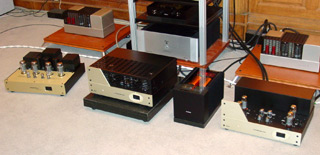 The street is
deserted, save for a few brave spectators who stand unafraid, having witnessed this scene
many times before. Many weeks have passed since this town last saw rain, leaving the
landscape coated in a gritty powder. The wind blows perpendicular to the street, sending
whirls of sand that scratch the eye and fill the lungs of the dust-covered inhabitants.
Standing facing each other at some distance the scraggly outlaws wait, hands on their
guns, watching for the slightest twitch from their opponent.
The street is
deserted, save for a few brave spectators who stand unafraid, having witnessed this scene
many times before. Many weeks have passed since this town last saw rain, leaving the
landscape coated in a gritty powder. The wind blows perpendicular to the street, sending
whirls of sand that scratch the eye and fill the lungs of the dust-covered inhabitants.
Standing facing each other at some distance the scraggly outlaws wait, hands on their
guns, watching for the slightest twitch from their opponent.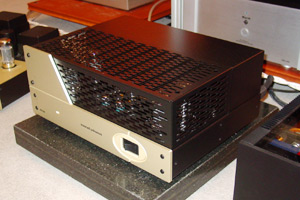 So when C-J introduced the
MV60, using the better transformers found in their Premier-series amps, I was ready to
trade. The MV60 tightened the bass, extended the highs, and even improved (could it be
possible?) those middle frequencies. Paired with my JMlab Micro Utopia speakers, this was
a match made in heaven.
So when C-J introduced the
MV60, using the better transformers found in their Premier-series amps, I was ready to
trade. The MV60 tightened the bass, extended the highs, and even improved (could it be
possible?) those middle frequencies. Paired with my JMlab Micro Utopia speakers, this was
a match made in heaven.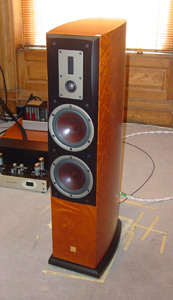 As the three amps were plugged
in and warming up, I detected a sheepish look on Jess’s face. I quickly read the look
as one of those "this could end up costing me money" kinds. That’s the
trouble with shootouts with your own equipment. If you don’t feel like your piece
came out on top, it’s like a pebble in your shoe. Did I really want to do this to a
friend? Too late to stop now.
As the three amps were plugged
in and warming up, I detected a sheepish look on Jess’s face. I quickly read the look
as one of those "this could end up costing me money" kinds. That’s the
trouble with shootouts with your own equipment. If you don’t feel like your piece
came out on top, it’s like a pebble in your shoe. Did I really want to do this to a
friend? Too late to stop now.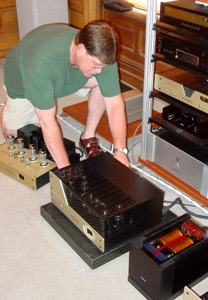 Next up was the Premier 11a. I
saw Jess hold his breath as he helped me change the cables. The Premier 11a is no
longer made, but there are those who will hold onto the idea that any amp without the
Premier name can’t compete.
Next up was the Premier 11a. I
saw Jess hold his breath as he helped me change the cables. The Premier 11a is no
longer made, but there are those who will hold onto the idea that any amp without the
Premier name can’t compete.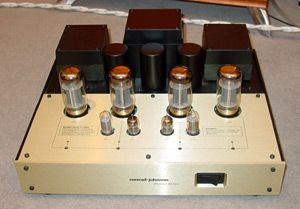 The Premier 11a would seem to be
the defeated party here, but is it really? The Premier 11, the 11a's predecessor, was
launched in 1993 and remained a top contender for almost a decade. It is still a
fine-sounding amplifier by anyone’s standard. It was only by direct comparison that
the newer amps were able to show their strengths. I have customers who love this amp and
will have it for years to come. The Italian is going to give me lots of trouble over this.
The Premier 11a would seem to be
the defeated party here, but is it really? The Premier 11, the 11a's predecessor, was
launched in 1993 and remained a top contender for almost a decade. It is still a
fine-sounding amplifier by anyone’s standard. It was only by direct comparison that
the newer amps were able to show their strengths. I have customers who love this amp and
will have it for years to come. The Italian is going to give me lots of trouble over this.